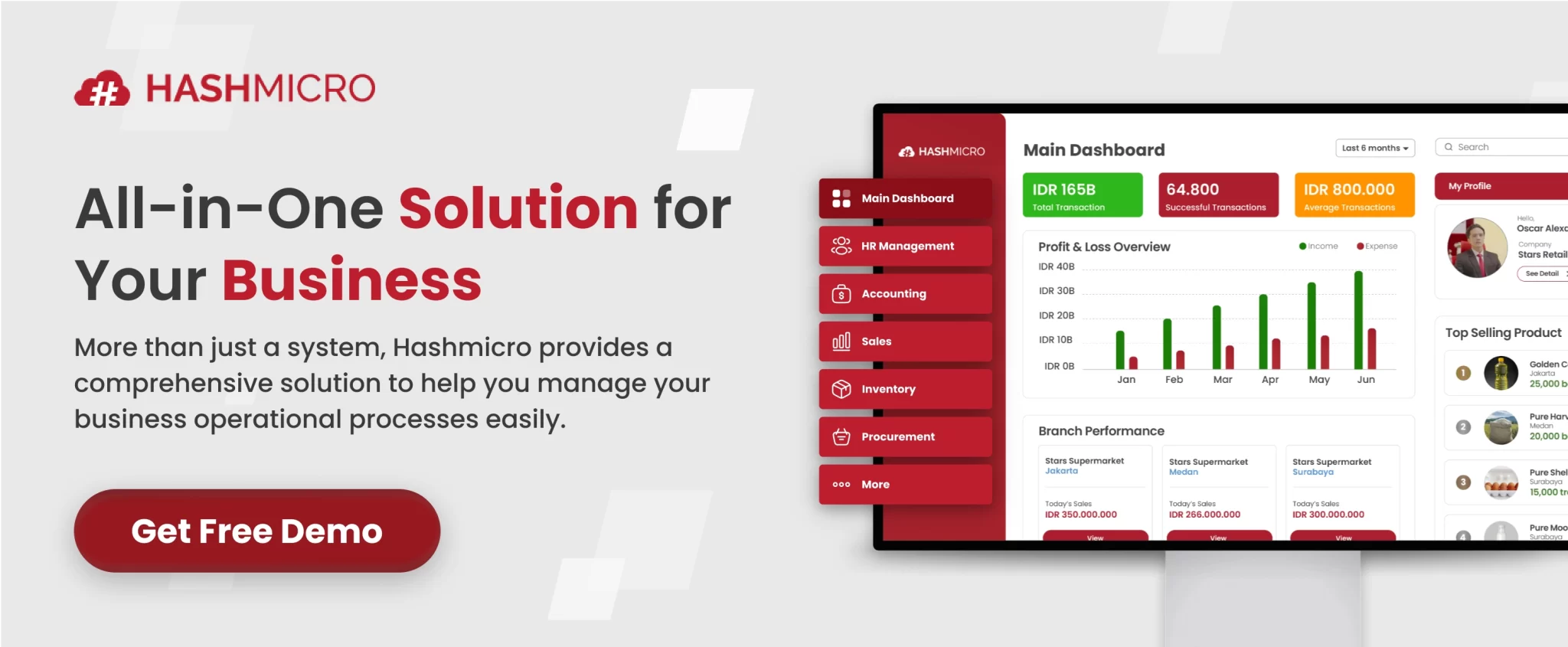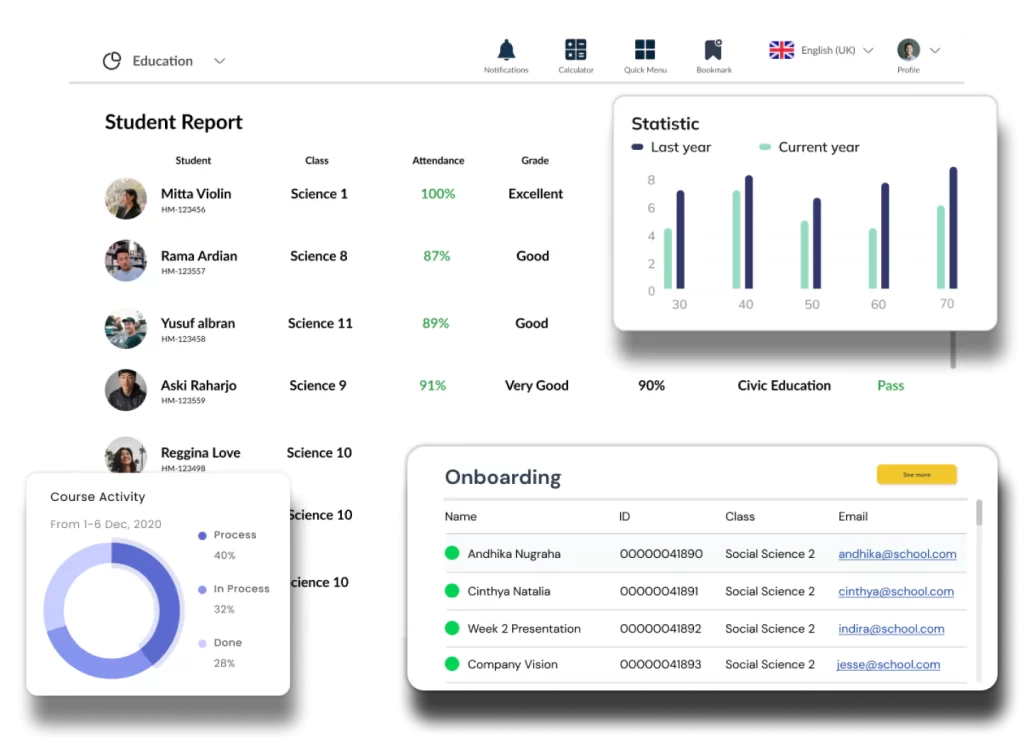Managing daily operations at my educational institution has always been a huge challenge. From handling student data to managing administrative tasks, it often feels overwhelming. As the institution grows, keeping everything running smoothly becomes even more difficult.
That’s why I see real value in an ERP system. The HashMicro School Management System helps me automate workflows, integrate data, and support real-time decision-making—tailored to the unique needs of schools, colleges, and universities.
I tried it myself, and the difference is remarkable. If you’d like to experience the same, try our free demo today and discover how ERP can simplify your institution’s operations and boost efficiency!
Key Takeaways
|
Table of Content:
Table of Content
What is ERP for Educational Institutes?
At my institution, I’ve seen how ERP for educational institutes can truly streamline operations. It helps us manage administration, curriculum, attendance, student data, and fees much more efficiently.
I also find it valuable that all departments are connected to a central system. This eliminates redundant data, automates routine processes, and makes our staff more productive. It has also improved information sharing across departments and locations, while keeping communication clear between management, staff, and students.
With ERP education software, I now have a centralized dashboard view of all the important information. For example, I can track students’ progress anytime I want, which gives me more time to focus on teaching.
Parents also appreciate staying informed about their child’s development, which strengthens the connection between the institution and families. And with access to real-time data and analytics, I’ve noticed a big improvement in productivity and in the way we plan, design, and operate academic resources.
Also read: Main Benefits of Implementing ERP Solutions for School
Hashy AI Fact

Need to Know
Many schools have transitioned from traditional POS systems to AI solutions. With AI for the School Management System, time-consuming tasks are automated and overall communication became more efficient.
Request a free demo today!
What are The Challenges Faced by Educational Institutes?
From my experience, educational institutes are never far from challenges, and that’s what pushes us to keep looking for effective solutions. One of the most impactful solutions I’ve found is ERP implementation. The following are some of the challenges we often face in our institution.
1. Institute and student data security

In my experience, the biggest threats we face are malware, phishing attacks, outdated technology, and a lack of awareness about data loss risks. This becomes even more critical in higher education, where research papers, patents, and intellectual property make our institution highly vulnerable to cyber-attacks.
2. Parents, teachers, and students communication
I’ve noticed that effective parent-teacher-student communication is a major challenge today, especially with parents’ busy schedules despite their strong desire to stay involved. In my institution, many parents struggle to visit frequently, making it essential for us to build consistent and convenient communication channels.
3. Productivity management
At my institution, manually maintaining large student and administrative records is exhausting and often diverts educators from their teaching responsibilities. I’ve also seen how students juggling multiple assignments face similar struggles, which is why smart writing help for students is essential to improving productivity, teaching quality, and overall engagement.
4. Class scheduling
In my experience, class scheduling is a major challenge as we try to balance teacher availability, subject requirements, student preferences, and extracurricular activities. Without an efficient system, I’ve seen how conflicts and errors can disrupt the learning process and negatively impact the overall academic experience.
5. Finance management
In my role, I’ve learned that managing finances effectively is crucial, from tuition fee collection to budgeting, payroll, and expense tracking. Relying on manual processes is time-consuming and error-prone, which is why I see the need for a robust system that automates financial operations and ensures transparency.
6. Ineffective technology
In my institution, I’ve seen how outdated systems, software issues, and poor integration slow down daily operations and create information gaps. These challenges cause delays and errors, so upgrading our technology infrastructure is essential to boost efficiency and improve the learning experience.
Implementing an effective ERP (Enterprise Resource Planning) solution tailored to the specific requirements of educational institutes can address these challenges and streamline operations.
What are The ERP Solutions for Educational Institutes?
From my perspective, ERP solutions offer comprehensive features and functionalities that cater to the specific needs of educational institutions. With the global education ERP market valued at USD 16.42 billion in 2023 and projected to reach USD 61.23 billion by 2030, it’s clear that adoption is accelerating.
Let me walk you through some of the key ERP solutions I consider essential for educational institutions.
1. Automation
Automation is one of the essential features of any ERP system. ERP is designed to automate a variety of tasks, particularly those that you perform regularly. One example of regularly recurring work that ERP could do for you is generating a report of the money your institution spent last month.
The software automatically brings specific information from all of the system’s applications. As a result, you don’t have to search for the information you need.
Even better, with good ERP systems, you can configure regular reports to present the information based on the format you want accurately. As you can see, ERP software can save you time through automation processes. Thus, it will benefit your institution’s financial bottom line as well.
2. Course Management
ERP solutions provide robust course management features that enable institutes to create, manage, and track courses effectively. This includes course planning, scheduling, curriculum management, assignment tracking, and grading. With course management software, educational institutes can ensure smooth and efficient delivery of their courses.
3. Student & Faculty Management
ERP software offers comprehensive student and faculty management capabilities. These solutions allow institutes to efficiently manage student enrollment, admissions, attendance tracking, performance monitoring, and faculty information.
The software facilitates seamless communication between students, faculty, and administrators, enhancing collaboration and engagement.
4. Tuition Fee Management
ERP solutions streamline tuition fee management by automating processes such as fee collection, billing, invoicing, and payment reminders. This simplifies financial transactions and provides real-time visibility into fee-related data. Institutes can efficiently track tuition fees and ensure transparency and accuracy in their financial operations.
5. Library Management
ERP solutions include library management software that helps educational institutes optimize their library services. The software offers features such as cataloging, circulation management, resource tracking, reservation systems, and advanced search options.
With advanced library management capabilities, institutes can provide a seamless experience to their students and faculty.
6. Task Manager
In my institution, I rely on ERP solutions with task management features to track and manage tasks more efficiently. With the task manager module, we can create assignments, monitor progress, prioritize tasks, and manage deadlines, ensuring smooth coordination among staff and faculty.
7. Absence and Leave Tracker
ERP software offers absence and leave tracking functionality to manage student and faculty attendance. The software provides a centralized system to record absences, and leaves, and generate reports for analysis and decision-making purposes. This helps institutes maintain accurate attendance records and streamline attendance management processes.
8. Operational Efficiency
ERP solutions enhance operational efficiency by automating and streamlining various administrative processes. This includes data entry, document management, report generation, and system integration. By leveraging the best ERP software, educational institutes can reduce manual work, minimize errors, and improve overall productivity.
9. Advanced Technology
ERP solutions leverage advanced technologies such as cloud computing, artificial intelligence, and machine learning.
These technologies enhance the capabilities of the software, providing powerful functionalities and improving overall performance and user experience. Educational institutes can stay ahead with cutting-edge technologies and drive innovation.
10. Improve Parents-Teachers-Students Communication

ERP systems facilitate seamless communication between parents, teachers, and students. Online portals, messaging systems, notifications, and progress reports enable effective and timely communication, keeping all stakeholders informed and connected.
Improved communication strengthens the collaboration and engagement between parents, teachers, and students.
11. Institute Finance Tracking
ERP software provides robust financial tools for educational institutes, managing budgeting, expense tracking, payroll, and detailed financial reporting. With comprehensive finance tracking features, institutes can ensure transparency in their financial operations and comply with regulations.
12. Efficient Data Security
In my institution, I rely heavily on ERP solutions with task management features to stay on top of daily responsibilities. I use the task manager module to create assignments, track progress, set priorities, and manage deadlines, which helps me and my colleagues coordinate smoothly across staff and faculty.
How to Choose The Right ERP for Educational Institutes
From my experience, selecting an ERP system for an educational institute requires careful evaluation of several factors. By considering these aspects, I can ensure the ERP solution I choose truly fits my institution’s needs. Here are some key factors I always keep in mind during the selection process:
1. Identify specific organizational needs:
Start by assessing the specific requirements and pain points of your educational institute. Consider factors such as student enrollment, admissions, attendance tracking, finance management, and communication needs. This assessment will help you understand the functionalities and features that your ERP system should have.
2. Scalability and flexibility:
Choose an ERP solution that is scalable and flexible. Ensure that the chosen system can accommodate future growth and adapt to changing needs and technological advancements. This way, you can future-proof your institute’s operations and avoid the need for frequent system upgrades.
3. Vendor reputation and experience:
When choosing an ERP vendor for your educational institute, research their reputation and experience in the sector. Seek vendors with a proven track record in delivering ERP solutions to educational institutes. Review customer feedback, testimonials, and case studies to assess their expertise and suitability for your institute’s needs.
4. Integration capabilities:
Ensure the chosen ERP system seamlessly integrates with existing systems like learning management or student information systems. This integration streamlines data flow, preventing duplicate entry and enhancing overall efficiency.
5. Customization options:
I always make sure to check the level of customization and configuration options in an ERP system. For my institution, having a solution that can be tailored to our specific needs and workflows is crucial, as it ensures the system truly complements our unique processes and requirements.
6. Training and support:
Assess the training and support offered by the ERP vendor during implementation and ongoing usage. Look for vendors providing comprehensive training programs to enhance staff proficiency. Additionally, prioritize vendors offering responsive customer support to address any system-related issues promptly.
7. Total cost of ownership:
Consider the total cost of ownership when selecting an ERP solution. This includes implementation costs, licensing fees, maintenance charges, and ongoing support costs. Ensure that the chosen ERP solution fits within your institute’s budget without compromising on essential functionalities and support services.
By considering these factors and evaluating ERP solutions against clear criteria, I can choose the right ERP system for my institution. This decision helps me streamline operations, boost efficiency, and foster better collaboration among staff, students, and parents.
“ERP for educational institutes is no longer a luxury but a necessity. It streamlines operations, improves transparency, and enables educators to focus more on teaching rather than administration.”
— Angela Tan, Regional Manager
Conclusion
In my experience, ERP program education offers numerous advantages, including technological innovation and efficiency, as well as real-time data availability. It allows me and everyone involved in the academic process to stay connected and gain better visibility into the information we need.
HashMicro provides the best ERP software for educational institutes which is presented specifically for educational establishments to improve the effectiveness of allocating and operating academic resources significantly.
There is also a CTC Grants offer that can save you up to 70%, along with a tailored pricing scheme for this particular accounting software solution, making it a strategic and cost-efficient investment for schools and universities.
Many institutions are already taking advantage of automation, if you want to enjoy the same benefits, feel free to request a free demo of educational ERP from Hashmicro.
FAQ About ERP for Educational Institutes
-
What does ERP mean in the education sector?
An ERP (Enterprise Resource Planning) system in schools is designed to streamline and organize activities by integrating all major processes into a single platform. This includes student management, attendance, grades, timetables, fee collection, HR tasks, and communication.
-
Is ERP really effective for educational institutions?
Yes, an education ERP makes it easier to access key information such as staff data, student records, admissions, reporting, and timetables with greater convenience. It helps ensure smoother workflows, boosts staff productivity, and supports better student performance.
-
Do schools actually use ERP software?
Absolutely. Teachers, students, and administrators all benefit from ERP systems, which provide an efficient way to manage education processes. The best ERP for schools helps institutions save time, reduce costs, and improve overall performance and user experience.























































